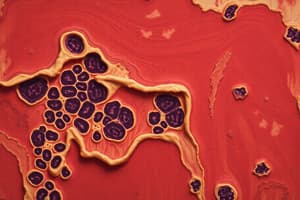Podcast
Questions and Answers
Skeletal muscle is responsible for involuntary movements in the body.
Skeletal muscle is responsible for involuntary movements in the body.
False (B)
Myofibrils in muscle cells contain only one type of contractile protein.
Myofibrils in muscle cells contain only one type of contractile protein.
False (B)
Cardiac muscle does not exhibit cross-striation like skeletal muscle.
Cardiac muscle does not exhibit cross-striation like skeletal muscle.
False (B)
The sarcoplasm of muscle cells is called sarcolemma.
The sarcoplasm of muscle cells is called sarcolemma.
The epimysium is a layer that surrounds muscle fascicles.
The epimysium is a layer that surrounds muscle fascicles.
Each muscle fiber contains multiple nuclei within the central region of the cell.
Each muscle fiber contains multiple nuclei within the central region of the cell.
Muscular tissue consists of cells called fibers.
Muscular tissue consists of cells called fibers.
Skeletal muscle is responsible for involuntary movements in the body.
Skeletal muscle is responsible for involuntary movements in the body.
The sarcoplasm of muscle cells contains actin and myosin filaments in a regular arrangement.
The sarcoplasm of muscle cells contains actin and myosin filaments in a regular arrangement.
Cardiac muscle is found in the walls of the heart and the walls of the pulmonary trunk.
Cardiac muscle is found in the walls of the heart and the walls of the pulmonary trunk.
Perimysium surrounds small bundles of muscle fibers called fascicles.
Perimysium surrounds small bundles of muscle fibers called fascicles.
Endomysium is a layer of connective tissue that surrounds skeletal muscles.
Endomysium is a layer of connective tissue that surrounds skeletal muscles.
Flashcards are hidden until you start studying




